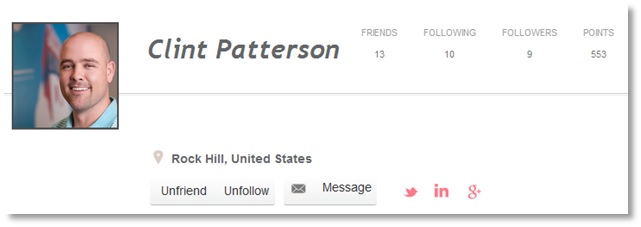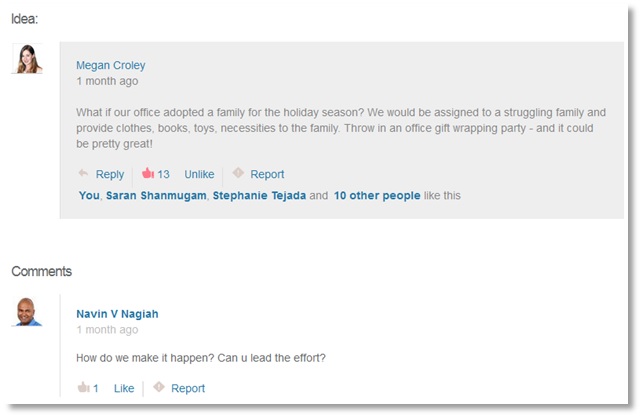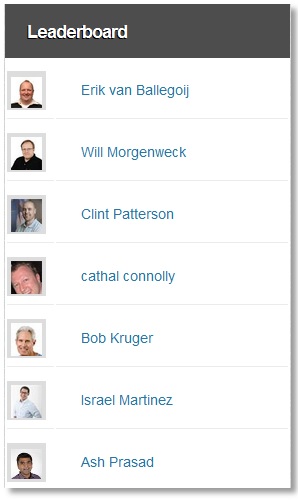In 2013, we migrated our company intranet from a conventional website to an engaging online community. We call the new intranet "Catalyst," as we wanted it to spur communication, enlightenment and change. Catalyst is powered by Evoq Engage.
Turning on our new intranet came as a pleasant surprise to everyone. In this blog post, I’ll detail the immediate benefits we realized in the short time since we launched Catalyst.
And We’re Off!

Pictured: My user profile in Catalyst.
When we first turned on Catalyst, I didn’t really know what to expect. I didn’t know if people would use it too much or how it would impact our organization. I spent the first few days checking out the features we implemented and how they were configured. Next, I updated my profile.
Over the next few days, more and more colleagues were logging in and communicating. Instantly, we noticed an increase in communications among employees, which helped create an initial buzz, but the initial buzz wasn’t all that happened. Our internal community started to help solve other problems.
Turning Grey Areas to Black and White

Pictured: Navin (our CEO) asks a question to employees.
Along with increasing the effectiveness of internal communications, Catalyst helped us do several other things, one of which was to remove grey areas that existed in our organization. Our organization has employees all over the world and we frequently have co-workers who travel. Our CEO used the "Question and Answer" feature to ask whether or not our employees opted to have car insurance when getting rental cars when traveling.
Over the next few days, the question received several responses. The interesting thing about this question was the varying responses from everyone. I posted a response because I had previously opted to have car insurance.
The responses showed that not everyone knew our company policy. Ultimately, our HR Manager responded with the correct answer and even provided documentation for everyone that traveled in our organization. It turns out that we are covered when renting cars on trips.
Several employees (including me) had needlessly purchased rental car insurance. In this instance using our community solution cleared up a grey area. Cost savings over a 5+ year period? Tens of thousands of dollars.
Opening Up Communications Channels
Having a global company allows us to have a diverse workforce with multiple cultural perspectives. People work in various time zones throughout the day. However, being spread out presents some challenges as well. One of the main challenges is communicating across teams and across the organization.

Pictured: Colleague Chris Kendall publishes a new blog post.
As soon as we turned on Catalyst, we saw the walls start to come down. Where I would not have seen an update by our Support Team Manager before, I started seeing his team’s updates and stats and gained a better perspective of how they operate and what’s important to them. Before long, everyone started posting updates about themselves, their team, DNN in general, or just some new and neat technology they just learned about.
The Activity Stream in Catalyst makes everyone more aware of things that are going on across the company. The product teams hear what features the sales team says customers are inquiring about. The engineering teams hear what issues are being reported to the support team. Leadership has direct insight into the pulse of the organization and it’s constantly being updated. Since the implementation of Catalyst, everyone in our company is now better informed and can convey any message within a few minutes.
From Mass Emails to Mass Engagement
Catalyst also greased the pathways of communications that were previously untouched. Before Catalyst, our leadership team would send out company-wide emails to communicate messages. Now, they publish blogs on Catalyst.
Recently, one of our co-founders decided to leave the organization. Our CEO (Navin) published a blog post, wishing him good luck in his new venture. Navin’s blog received numerous comments. The comments included personalized recollections (and words of thanks!) from colleagues who worked with our co-founder for many years.
Had this message been communicated via email, most people would be hesitant to “reply all.” In this instance, the social community gave everyone the avenue to communicate and seeing other employees comment on the blog entry gave other employees confidence in making comments. Rather than the situation being awkward, it became social!
Managing the Growing Repository of Institutional Knowledge
Catalyst provided our sales team with a unique opportunity. In the past, Sales fielded questions from potential leads and posted them in Salesforce. This process worked well, but it wasn’t perfect. A Sales Engineer would answer the question and post a response to the case.
The salesperson would then respond to the lead with the answer. The problem with that scenario is that the interaction and exchange of knowledge happened in a vacuum. One person had a question and it was answered by another person. The knowledge gained in this exchange slowly faded away, with no one else benefiting from the transaction.

Pictured: Sales team got questions? The entire organization has answers.
With Catalyst, we were able to change that process and open that transaction of knowledge to everyone in the organization. Now, instead of posting questions in Salesforce, questions are submitted in Catalyst. This offered instant benefits to the sales team. They started getting responses not just from Sales Engineers, but also from the developers, engineers, and product teams.
These interactions were now available for everyone to see. Beyond that, they are added to the platform’s search index. This means that when a question is asked, it doesn’t go into oblivion, but it stays on the site. Later, if someone has a related question, they will instantly see the exchanges that happened around that subject.
Crowdsourced Innovation
Catalyst has an “ideation” feature. This feature allows users to submit and vote on ideas in our community and thus drive product, service, website, and organizational innovation. Over time, the best ideas naturally float to the top.
Employees quickly started submitting ideas to the ideas page. As an endorsement of the management team, our ideas were heard. There are too many ideas to cover in a single blog post, but I’ll highlight a few that have stood out.
Two early ideas were to add an employee’s extension number to their profile and to have the capability of launching a Skype call at the click of a button. Our solution is very flexible and extensible, so both of those ideas were implemented fairly quickly.

Pictured: Colleague Megan Croley submits an idea.
Next, an “Adopt a Family for Christmas” idea went viral in our company. This idea was posted and instantly gained traction, got accepted, and within a few weeks went from an online suggestion to a real-life, magical and unexpected Christmas for a family of eight.
Everyone in the company now has a voice to get a movement started. The ideation feature has empowered everyone to be a “change agent” and ultimately increase efficiency, change processes, and make our organization better.
Who’s In First?

Pictured: Our intranet's leaderboard. Notice who's in third place?
In Catalyst, we have a leaderboard that lists employees in descending order of reputation points. As employees participate, interact and contribute, we earn points, which causes our position on the leaderboard to fluctuate.
The gaming mechanics engine can be configured to align with an organization’s objectives. In our intranet, we’re rewarded most for answering questions and for contributing innovative ideas. But it’s not just a matter of submitting lots of answers. Quality answers (e.g. those that are “liked” or “up-voted”) get far more points than non-quality answers.
In an office setting, you’re naturally see a lot of friendly competition among colleagues. The leaderboard is visible on multiple pages, so it’s easy to know which users are close to you in the standings. Ultimately having your community members competing in your community can benefit your organization. The desire to compete can drive site activity and engagement. I’ve seen that firsthand here at DNN.
In Their Own Voice
You don’t have to believe me. Let me allow my colleagues to chime in on the impact of Catalyst. I posted a request in the Activity Feed of Catalyst, asking that my peers share their thoughts. Here are some of the responses I received:
“Great opportunity to provide visibility to yourself, just about everyone in the organization is on the site.” (Ash P.)
“When questions arise, valuable insights can be shared by someone that you may not have thought to ask.” (Megan C.)
“I have a much broader understanding of what Sales and Marketing are doing on a daily basis.” (Ken G.)
“Info, comments, opinions, etc. are persisted in a way that doesn't require people to search through their individual mail boxes.” (Bob K.)
“The ability and freedom for anyone to share their thoughts with utmost visibility, which in other ways it's impossible to achieve.” (Saran S.)
“It’s helped me ‘meet,’ get to know and interact with colleagues in a way that wouldn't have been possible without it.” (Dennis S.)
Conclusion
Turning on a social community has benefited the company in more ways than one. Now I feel like I can spread a message, ask a question, or submit an idea company-wide within a matter of minutes.
Since turning on our internal community we’re experiencing a new, more efficient reality. We now have a new information hub, a new synergy and a place where anyone can innovate. Communications have increased among employees. I’m glad we turned our intranet into a social community. Turns out “Catalyst” was a most fitting name.
Request a Custom Demo
Our intranet is powered by Evoq Engage. Want to see how Evoq Engage can work for your organization? Request a custom demo today.